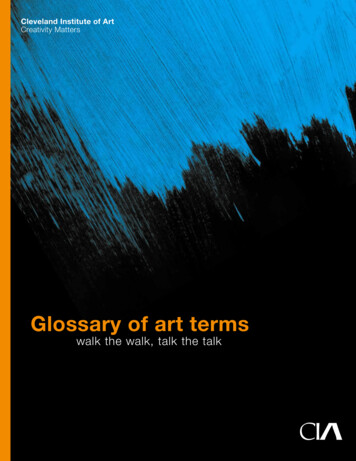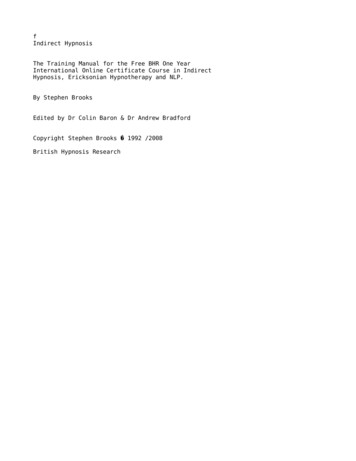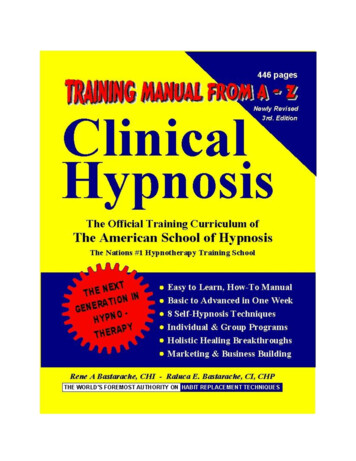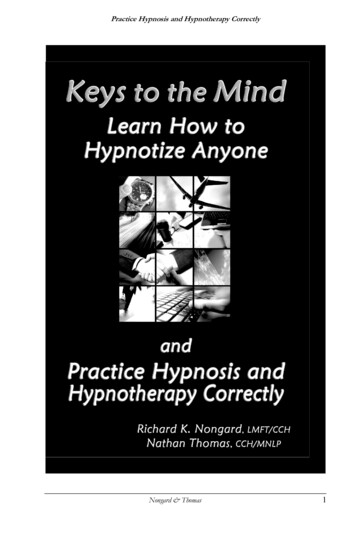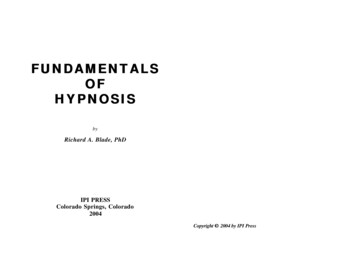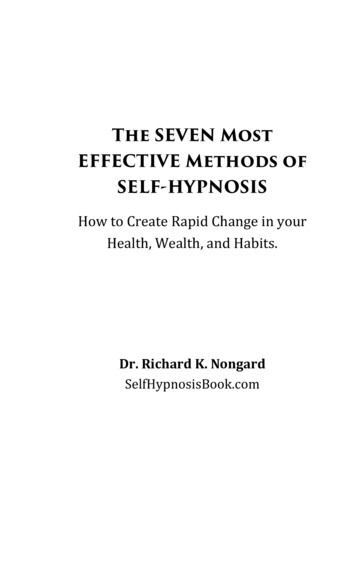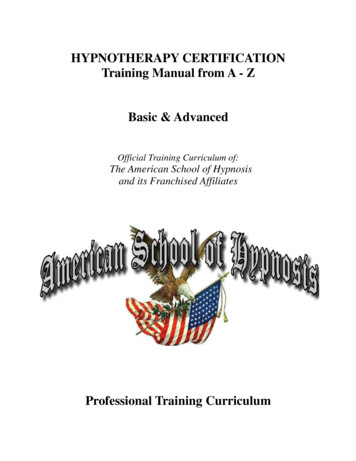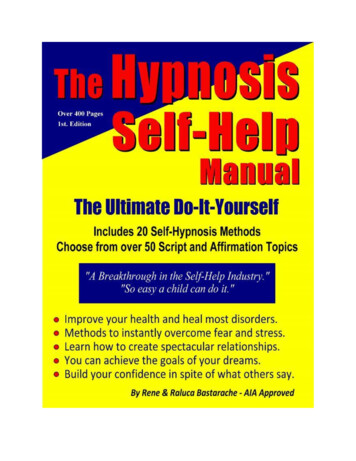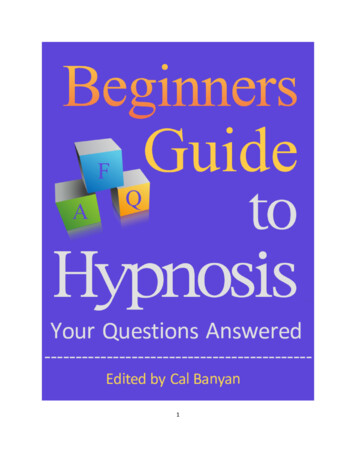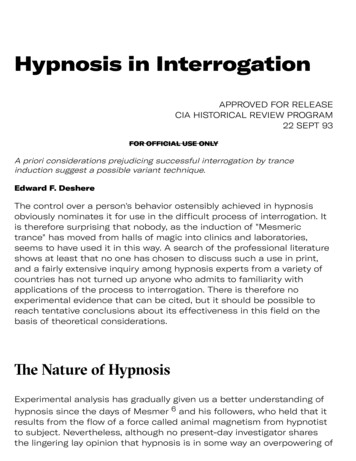
Transcription
Hypnosis in InterrogationAPPROVED FOR RELEASECIA HISTORICAL REVIEW PROGRAM22 SEPT 93FOR OFFICIAL USE ONLYA priori considerations prejudicing successful interrogation by tranceinduction sugest a possible variant technique.Edward F. DeshereThe control over a person's behavior ostensibly achieved in hypnosisobviously nominates it for use in the difficult process of interrogation. Itis therefore surprising that nobody, as the induction of "Mesmerictrance" has moved from halls of magic into clinics and laboratories,seems to have used it in this way. A search of the professional literatureshows at least that no one has chosen to discuss such a use in print,and a fairly extensive inquiry among hypnosis experts from a variety ofcountries has not turned up anyone who admits to familiarity withapplications of the process to interrogation. There is therefore noexperimental evidence that can be cited, but it should be possible toreach tentative conclusions about its effectiveness in this field on thebasis of theoretical considerations.Te Nature of HypnosisExperimental analysis has gradually given us a better understanding ofhypnosis since the days of Mesmer 6 and his followers, who held that itresults from the flow of a force called animal magnetism from hypnotistto subject. Nevertheless, although no present-day investigator sharesthe lingering lay opinion that hypnosis is in some way an overpowering of
a weak mind by a superior intellect, there are still many divergenttheories propounded to account for the accumulating clinicalobservations. Some of these have significantly different implicationswith respect to the susceptibility of a hypnotized person to purposefulinfluence.The view that hypnosis is a state of artifically induced sleep has beenwidely held since Braid 7 invented the term in mid-nineteenth-century.Currently Pavlov 20 takes a similar position in maintaining that corticalinhibition, sleep, and hypnosis are essentially identical. This view is nowheld throughout those parts of the world where Pavlovian theory isaccepted as creed, but to the American investigator the experimentalevidence against it appears overwhelming. Bass,3 for example, hasshown that the patellar--kneecap--reflex, which disappears in sleep, isnot diminished in hypnosis. Wells 27 and others have demonstrated thatall hypnotic phenomena can be elicited in a state bearing noresemblance to sleep, a performance which sugests the hypothesisthat sleep-like aspects of hypnosis are not intrinsic to the hypnotic statebut result from the hypnotist's sugestion that his subject go to sleep.Barker and Burgwin 2 have shown that the electroencephalographicchanges characteristic of sleep do not occur in hypnosis except whentrue sleep is hypnotically induced. The findings of two Russian papers 16which dispute this conclusion, affirming that the EEG rhythmcharacteristic of hypnosis resembles that of drowsiness and light sleep,have not been verified by replicating their experiments.The concepts of sugestion and sugestibility as applied to hypnosis,introduced about 1880 by the Nancy school of hypnosis investigators,have been developed and refined in modern times. In a majormonograph Hull10 concluded that hypnosis is primarily a state ofheightened sugestibility and has the characteristics of habit in that itbecomes increasingly easy for a subject to enter the state of hypnosisafter he has once done it. Welch,26 in an ingenious application of theconditioning theory, pointed out that trance induction begins withsugestions which are almost certain to take effect and proceeds tomore difficult ones. While the concept of sugestion does provide abridge between the hypnotic and the normal waking state, it does notexplain the peculiarity of the hypnotic process or the causes of the stateof trance.Several more recent approaches, which might be called motivational
ppr, which mightheories of hypnosis, hold that achievement of trance is related to thesubject's desire to enter such a state. Experimentalists and clinicianswho take the motivational view--including the present writer, whoseconclusions on the subject of this paper are undoubtedly colored by it-believe that it accounts best for the major portion of the clinical data.Trance is commonly induced in situations where the subject ismotivated a priori to cooperate with the hypnotist, usually to obtain relieffrom suffering, to contribute to a scientific study, or (as in a stageperformance) to become a center of attraction. Almost all informationcurrently available about hypnosis has been derived from suchsituations, and this fact must be kept in mind when one attempts toapply the data theoretically to situations different from these.Hypnosis of InterrogeesThe question of the utility of hypnosis in the interrogation of personsunwilling to divulge the information sought involves three issues: First,can hypnosis be induced under conditions of interrogation? If so, canthe subject be compelled to reveal information? And finally, ifinformation can be so obtained, how reliable will it be? The initialproblem is then to induce trance either against the subject's wishes orwithout his being aware of it.The Subject Unaware. Hypnosis has reportedly been effected without thesubject's awareness in three situations--in sleep, in patients undergoingpsychiatric consultation, and spontaneously in persons observinganother subject being hypnotized.The older literature is replete with references to somnambulistichypnosis induced by giving sugestions to sleeping subjects in a low butinsistent voice. No case records are cited to support these statements,however; and they appear, like many others in hypnosis literature, tohave been carried over from one textbook to another without criticalevaluation. In a recent study Theodore X. Barber 1 found considerablesimilarity between subjects' compliance with sugestions given duringsleep and their reactions to ordinary hypnotic techniques. Since Barberhad asked them for permission to enter their rooms at night and talk tothem in their sleep, however, it is reasonable to assume that most if not
epall of them perceived that trance induction was his purpose. Theycannot therefore be regarded as truly naive sleeping subjects. Casualexperimentation by the present writer has failed to demonstrate thefeasibility of hypnotizing naive sleepers. The sample consisted of onlyfour subjects, three of whom awakened to ask belligerently what wasgoing on. The fourth just continued to sleep.It is frequently possible for a therapist to perform hypnosis with thepatient unaware. Advising the patient to relax, sugesting that he wouldbe more comfortable with his eyes closed, and so on, the practitionermay induce a deep level of trance in a relatively brief time without everusing the term hypnosis. Even though the subject has not explicitlyconsented to be hypnotized, however, his relationship to the hypnotist,here a man of reputation and prestige, is one of trust and confidence, ofjustifiably anticipated help.Observers of hypnotic demonstrations may spontaneously enter trance.One of my own psychotherapy patients has reported that she went intoa trance while watching me demonstrate hypnotic phenomena ontelevision. This spontaneous hypnosis occurred despite the fact that thepatient was in the company of friends and it was therefore a source ofembarrassment to her. But here again we are dealing with a subject insympathy with the purposes of the hypnotist and one who feels himselfto be in a safe situation. It has been noted clinically that persons withnegative attitudes about hypnosis are not susceptible to spontaneoustrance.The Subject Antagonistic. In experiments conducted by Wells 29Brenman,8 and Watkins,25 subjects making an effort to resist tranceinduction were unable to fight it off. Space does not permit a full reviewof these experiments here, but in all three the subject had had previoustrance experiences with the hypnotist, which, we may assume, initiateda positive relationship between subject and hypnotist. The subject wasinstructed to resist hypnosis, but in the context of participating in anexperiment to test this issue. It seems possible that his response wasone of compliance with a supposed implicit desire on the part of theexperimenter that he collaborate in demonstrating that trance can beinduced in the face of resistance. The demand characteristics of thesituation--those influencing the subject to partake of the experimenter'spurposes--may have been such that his prescribed attitude of overtresistance was unable to prevail over the more fundamental attitude ofcooperation in an experiment to show that trance can be brought on
opxpagainst a subject's will.ughOrne 18 has shown that the demand characteristics of an experimentalsituation may greatly influence a subject's hypnotic behavior. It is clearthat at some level any cooperative subject wishes an experiment to"work out," wishes to help fulfill the experimenter's expectations. If hegrasps the purpose of the experiment or the bias of the experimenter, heis disposed toward producing behavior which will confirm theexperimenter's hypothesis. This is particularly true in a hypnoticrelationship.We are led to the conclusion that the many apparent cases of hypnosiswithout the subject's awareness or consent all seem to have dependedupon a positive relationship between subject and hypnotist. The mostfavorable situation is one in which the subject expects to derive benefitfrom his association with the hypnotist and trusts in the hypnotist andhis ability to help. This would not be the situation in an interrogationwherein the hypnotist is seeking to extract information which thesubject wants to withhold. The possibility of using hypnosis wouldtherefore seem to depend on success in the slow process of nurturing apositive relationship with the interrogee or in perpetrating some kind oftrickery.Obedience in TranceAssuming that an interrogator has circumvented these problems andhypnotized a subject who wants to withhold information, to what extentmight the subject retain control of his secrets even in deep trance? Thisis an area where wide disagreements prevail among authorities andwhere experimental evidence is highly contradictory. Young,30 forexample, reports that subjects resist specific hypnotic sugestions ifthey have decided in advance to do so, while Wells 28 reports that noneof his subjects were able to resist a prearranged unacceptablecommand or indeed any other.Most work on this problem has focused on the more specific question ofwhether a person can be induced under hypnosis to commit someantisocial or self-destructive act. Supporting the negative view is the
classic experiment by Janet,11 who asked a deeply hypnotized female tocommit several murders before a distinguished group of judges andmagistrates, stabbing some victims with rubber dagers and poisoningothers with sugar tablets. She did all this without hesitation. As thecompany dispersed, however, she was left in the charge of some youngassistants, who took a notion to end the experiments on a lighter note.When they told her that she was now alone and would undress shepromptly awakened. The murders were play-acted, the undressing wouldhave been real; and the subject had no difficulty discerning thedifference.Wells,29 on the other hand, caused a subject to commit the posthypnotic theft of a dollar bill from the hypnotist's coat. The subject wasunaware of his action and denied vehemently that he had stolen themoney. Wells argues that other failures to compel such acts do notdisprove the possibility of doing it, whereas even one successdemonstrates that it can be done. Schneck and Watkins, also, citeevidence that behavior ordinarily constituting a crime can be producedby hypnosis. Schneck 22 inadvertently caused a soldier to desert hisduty order to carry out a sugestion for post-hypnotic action. Watkins 24induced a soldier to strike a superior officer by sugesting that theofficer was a Japanese soldier, and he obtained from a hypnotized WACsome information classified "secret" which she had previously told himshe would not reveal.Although these demonstrations appear convincing, there aredeficiencies in their experimental conditions. Since both Schneck andWatkins were Army officers, the offenses committed could not possiblyresult in any serious damage. At some level, the subjects must havebeen aware of this. This same reasoning applies in experiments requiringa subject to hurl acid at a research assistant or pick up a poisonoussnake: the participants are protected by invisible glass, a harmlesssnake is substituted for the poisonous one, and so forth. The situationsare clearly experimental and the hypnotist who requests the homicidalor self-destructive behavior is known to the subject as a reputable man.From real life there are a fair number of cases on record dating before1900, particularly among the German-speaking peoples, claiminghypnotically induced criminal behavior, mostly sex offenses. It is hard toevaluate these cases scientifically at this late date; frequently it wasrelatives of the subject, rather than the offender himself, that charged
hypnotic influence. Within recent years, however, three documentedcases in which hypnosis is said to have played a role in criminal behaviorhave been reported--by Kroener,18 Mayer,14 and Reiter.21 These threecases have a common element: in each a dissatisfied person foundgratification through the individual who later became his seducinghypnotist. It will be sufficient to examine one of them.In the case reported by Kroener a young and sensitive unmarried maleschoolteacher came under the hypnotic influence of a neighbor.Beginning with neighborly hospitality, the neighbor built up therelationship to the point where he was able by hypnotic sugestion toget the schoolteacher to give or lend him small sums of money andgoods. As a test of his power he then implanted the post-hypnoticsugestion that the schoolteacher
Hypnosis has reportedly been effected without the subject's awareness in three situations--in sleep, in patients undergoing psychiatric consultation, and spontaneously in persons observing another subject being hypnotized. The older literature is replete with references to somnambulistic hypnosis induced by giving sugestions to sleeping subjects in a low but insistent voice. No case records .

